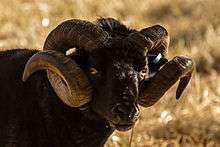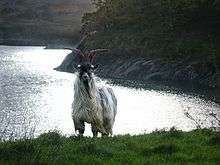Dutch Landrace goat

The Dutch Landrace goat breed is one of the original breeds found in the Netherlands. It is related to other northwest European "Landrace"-named goat breeds. There is a herd of approximately 1000 used on national reserves to keep naturally open areas free of trees.
History
The Dutch Landrace goat was dying out by the mid 20th century and only had a few left in the world as of 1958. A breeding program was designed to save the breed and since then has built the breed back up to 2000 that are registered in the LFNL herd book (National Association of Dutch Feral Goat Breeders).
Characteristics
The breed is primarily a milking breed but can be used for meat or fiber production. Since there is so few left in the breed it is not used commercially. It is a medium-sized goat with long hair that can come in a few different shades of brown. The breed has characteristically short limbs and grows to a maximum of 65 cm, with females weighing up to 60lbs and males up to 80lbs.
Horns
There are several different horn structures that the Dutch Landrace can exhibit.
Ammon horn

This type of horn forms more or less a complete circle, as they rise steeply from the animals forehead and grow in a circular pattern from there. This horn growths is not typical of European goats generally and are more typical of sheep.
Scimitar

This horn type is typical of a wild goat, the horns diverge from one another with an untwisted core.

Dorcas
May be considered typical of the Dutch Landrace. The horns rise vertically from the forehead at a steep angle with little divergence in the initial growth then twist and diverge outward at right angles to the body. The horizontal growth does not drop below the plane of the forehead with the tips possibly being turned a little to even vertically upward. The core of these horns is untwisted similar to that of the core of the scimitar horns.
Moderate Twist
This style horn appears to be related to the dorcas style and is similar in most respects however this shows more of an "exotic" style. This horn type is associated with central and northern European goats generally and more so the northern breeds in particular.
Incipient Corkscrew
_(14745659761).jpg)
The angle of emergence in this style of horn is high initially then quickly twists outwards to the rear with the tips curving outwards and upwards. This horn type is not usually associated with European goat breeds typically.
See also
Sources
- Dutch Landrace
- Horn form of the Dutch Landrace Goat
- Dutch Landrace Goat
- Goat breeds
- Dutch Goat Breed
- http://www.landgeit.nl/
- Traditional Inspection of Dutch Landrace Goats